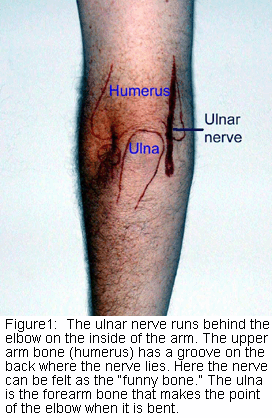 Description
Description
Ulnar nerve entrapment occurs when one of the nerves in the arm (the ulnar nerve) becomes compressed and can’t function normally. This can give symptoms of “falling asleep” in the ring finger and little finger, especially when the elbow is bent. You may have aching pain on the inside of the elbow.
In some cases, you may have trouble moving the fingers in and out, or manipulating objects. Carpal tunnel syndrome has similar symptoms but involves a different nerve (the median nerve). Carpal tunnel syndrome typically causes tingling in the thumb, index finger and long finger.
The ulnar nerve is one of the three main nerves in the arm. It travels from under the collarbone and along the inside of the upper arm. It passes through a tunnel (the cubital tunnel) behind the inside of the elbow. Here you can feel the nerve through the skin. It is commonly called the “funny bone.”
Beyond the elbow, the nerve travels under muscles on the inside of the arm, and into the hand on the pinky side of the palm. When the nerve goes into the hand, it travels through another tunnel (Guyon’s canal). The most common place where the nerve gets compressed is behind the elbow. Sometimes it gets compressed at the wrist, beneath the collarbone, or as it comes out of the spinal cord in the neck.
The nerve functions to give sensation to the little finger and the half of the ring finger that is near the little finger. It also controls most of the little muscles in the hand that help with fine movements, and some of the bigger muscles in the forearm that help to make a strong grip.
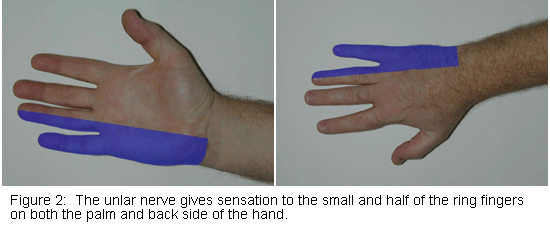
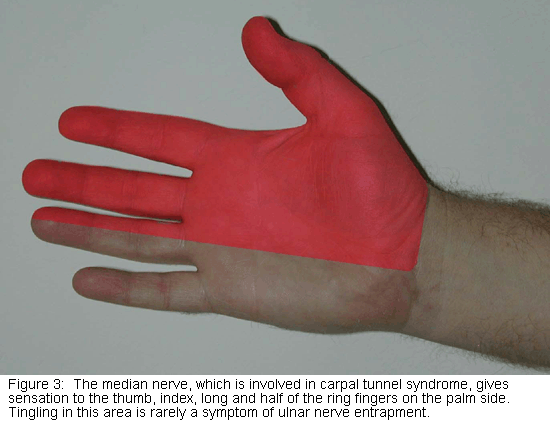
Risk Factors/Prevention
It is not known exactly what causes compression of the ulnar nerve. Some factors can make it more likely that the nerve will be compressed. These include prior fractures of the elbow, bone spurs, swelling of the elbow joint, or cysts. A direct blow to the inside of the elbow, leaning on the elbow for prolonged periods, or repetitive activity that requires a bent elbow can irritate the nerve if it is already compressed. If the ulnar nerve is compressed at the wrist, the cause is more likely to be a cyst in Guyon’s canal.
Symptoms
Numbness and tingling in the ring finger and little finger are common symptoms of ulnar nerve entrapment. Often these symptoms come and go. They happen more often when the elbow is bent, such as when you are driving or talking on the phone. Some people wake up at night because their fingers are numb. You may also have weakness of grip and difficulty with finger coordination (such as typing or playing an instrument). If the nerve is very compressed or has been compressed for a long time, muscle wasting in the hand can occur. Once this happens, muscle wasting cannot be reversed. For this reason, it is important to see the doctor as soon as you experience any of the symptoms.
Diagnosis
Always see an orthopaedist if you are having symptoms of ulnar nerve entrapment that interfere with normal activities or last more than a few weeks.
The doctor will examine the arm to check the nerve, and try to determine where the nerve is compressed. If the nerve is irritated, tapping over the nerve at the “funny bone” can cause a shock into the little finger and ring finger, although this can happen when the nerve is normal as well. The doctor will probably move the shoulder, elbow and wrist to see if any of these cause symptoms. The doctor will test the sensation in the fingers.
Although most causes of compression of the ulnar nerve cannot be seen on X-ray, the doctor may take an X-ray of the elbow or wrist to look for bone spurs, arthritis or other places that the bone may be compressing the nerve. If the doctor thinks that the nerve is compressed at the wrist, a CT scan (computed tomography) or MRI (magnetic resonance image) may be recommended to see if a cyst or other structure is the cause of the compression.
The doctor may recommend nerve conduction studies. These are special tests to determine how well the nerve is working and to help localize the area of compression. Nerves work like wires; when the nerve is not working well, it takes too long for the nerve to conduct. During this test, the nerve is stimulated in one place; the amount of time it takes for the response to be conducted to another place is determined. The area where the nerve conduction takes too long is likely to be the place where the nerve is compressed. Sometimes, a small needle is put into some of the muscles that the ulnar nerve controls. This can determine if there is any evidence of muscle wasting.
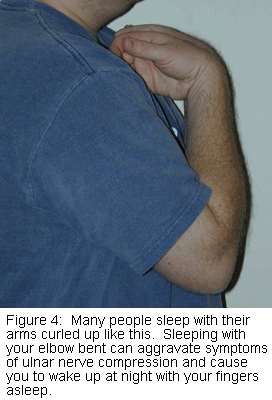 Treatment Options
Treatment Options
Unless you have a lot of muscle wasting, your doctor will probably recommend nonsurgical treatment initially. The following treatments may help to improve the symptoms. They may be all the treatment you need.
- Avoid frequent use of the arm with the elbow bent. If you use a computer frequently, make sure that your chair is not too low. Do not rest the elbow on the armrest.
- Avoid leaning on the elbow or putting pressure on the inside of the arm. For example, do not drive with the arm resting on the open window.
- Keep the elbow straight at night when you are sleeping. This can be done by wrapping a towel around the straight elbow, wearing an elbow pad backwards, or using a special brace.
If symptoms are acute, the doctor may recommend that you take an anti-inflammatory medicine such as ibuprofen to help reduce swelling around the nerve. Steroid (cortisone) injections around the ulnar nerve are not generally used because there is a risk of damage to the nerve.
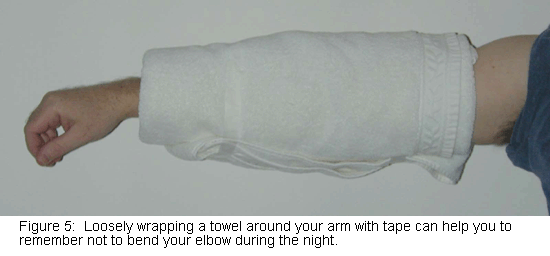
Some doctors think that exercises to help the nerve slide through the tunnels can improve the symptoms. These exercises can help keep the arm and wrist from getting stiff.
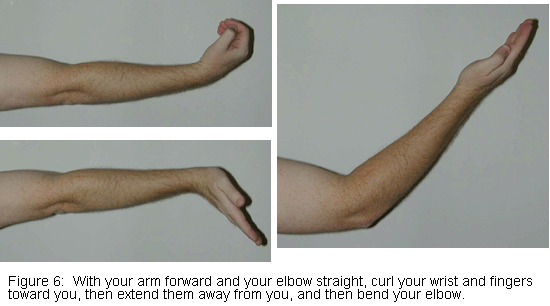
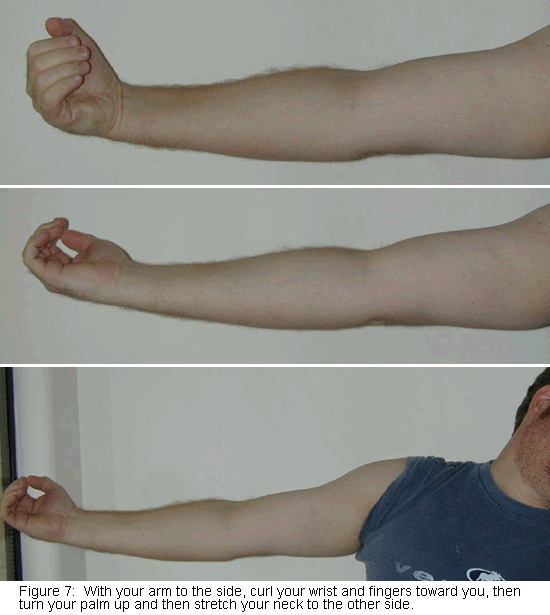
Treatment Options: Surgical
If you are not improving with the strategies listed above, if the nerve is very compressed, or if you have muscle wasting, the doctor may recommend surgery to take pressure off of the nerve. Most often, the surgery is done around the elbow, but it can be done at the wrist if that is the place of the compression. Sometimes, the nerve is compressed in both places, so surgery is done at both the elbow and the wrist.
Surgeons use various ways to relieve compression from the nerve around the elbow. All of the operations involve making an incision around the elbow. In one operation, only the “roof” is taken off of the cubital tunnel. This tends to work best when the nerve compression is mild. More commonly, the nerve is moved from its place behind the elbow to a new place in front of the elbow. This is called an anterior transposition of the ulnar nerve. The nerve can be moved to lie under the skin and fat but on top of the muscle (subcutaneous transposition), within the muscle (intermuscular transposition) or under the muscle (submuscular transposition). There are many factors that go into deciding where the nerve is moved. The doctor will recommend the best option for you.
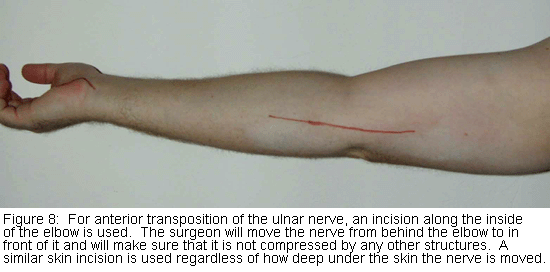
If the nerve is compressed at the wrist, a zigzag incision will be made at the base of the palm on the pinky side. The surgeon will open the roof of Guyon’s canal to take the pressure off the ulnar nerve. If there is a cyst or another reason for the compression, the surgeon will remove that at the same time.
The surgery is usually done on an outpatient basis or with an overnight stay in the hospital. Depending on the type of surgery, you may need to wear a splint for a few weeks after the operation. A submuscular transposition usually requires a longer time (3-6 weeks) in a splint. The surgeon may recommend physical therapy to help you regain strength and motion in the arm.
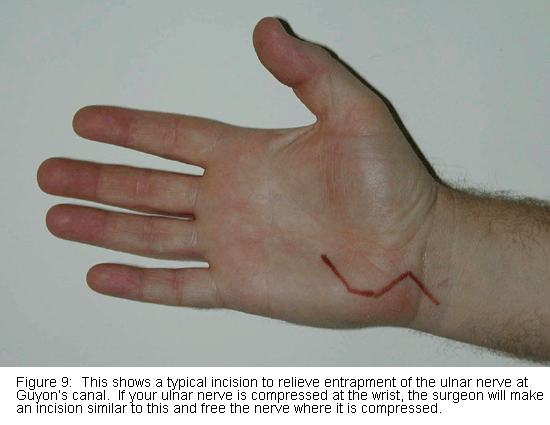
The results of the surgery are generally good. If the nerve is very badly compressed or if you have muscle wasting, the nerve may not be able to get back to normal and you may have some symptoms even after the surgery. Nerves recover slowly, and it can take a long time to know how well the nerve will do after the operation.
